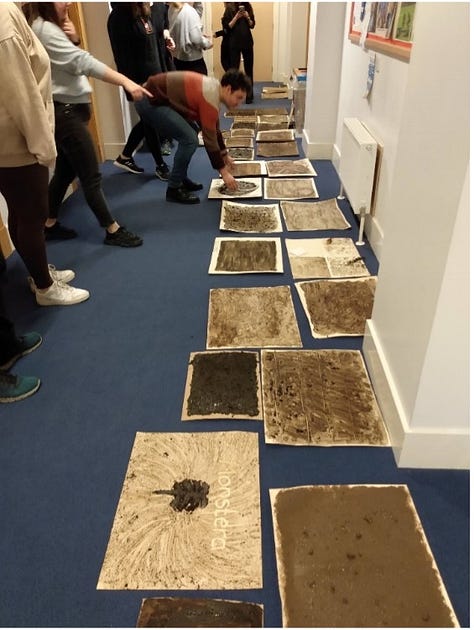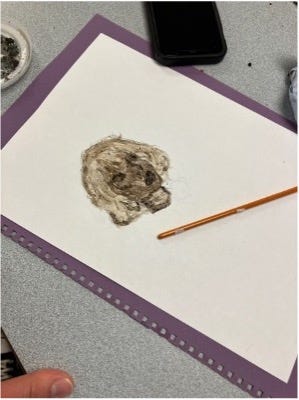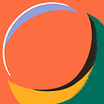As I sit down at the end of another year troubled by wars and environmental catastrophes, to write my contribution to this network of readers interested in the ever-expanding debate on the nature of interdisciplinary learning and the curriculum, an image comes to mind. It is a large, white satellite dish; one of those earlier types, often shown in sci-fi films from the seventies. I remember it from watching ‘The Dish’, a 2000 Australian comedy-drama that tells the story of the Parkes Observatory's role in relaying live television of humanity's first steps on the Moon during the Apollo 11 mission in 1969. After a power cut, the dish’s backup generator fails with a loss of the station's tracking computers programming for locating the signal in space.
Amongst the scientists, a mathematician takes charge of the equations for working out the exact angle at which the dish should be turned in order to receive the signal from the moon. Notwithstanding the sheer level of skill and perseverance, with the blackboard filled to the edges with formulas and chalk, every attempt leads to interference. Due to the high-winds and the lack of power, the signal was neither precise nor stable. The team almost gave up, when they decide to take matters in their own hands; as the clouds parted, the moon appears in the sky; they point the dish straight towards it, and Armstrong’ light-footed and slightly unstable step appears on screen.
In what way is this film saying anything about knowledge, education and ultimately, about curriculum, as we grapple with the big questions of what curriculum should do in today’s schools? This discussion is not only of academic interest, but it is remarkably timely for global policy1, and especially in Scotland, currently undertaking a review of Curriculum for Excellence.
Pointing to the moon
The moment when the team of scientists turned the dish - by manoeuvring its levers - was the historical moment when the wider public witnessed a human being taking their first step into an environment that never before had been part of human experience. While this might appear as a rather simple act, what lay behind it was a gesture, by which term I mean more than just the performance of an action. A gesture is part of a system of visual, linguistic signs which contains a subject, a verb signalling an intention, and an object, which is put to the attention of the viewers. In this case, the image of Armstrong stepping on the moon’s surface, crystallised the idea of a powerful humanity armed with sophisticated technological devices; but it also brought into view the more tentative image of a human encumbered by his/her own ignorance of what was stepping into.
There are many readings for such an image, but the point is not the deciphering; the power of a gesture lies in the witnessing of what happens when the viewer engages with the reality that is being presented to them.
And so, I ask the readers and myself, what happens when a science teacher decides to point to the moon as a topic in the curriculum? Is this gesture informed chalk in hand by the accurate calculation of when in the programme of studies this topic should feature in order to achieve an accurate transmission? Or is it more like that historical gesture, when a teacher decides to move the levers and turn the dish for everyone to see? I suggest that in between these two modalities of teaching lie very different conceptions of curriculum and of education.
Moving the levers
When we engage in discussion around curriculum review, a reference is commonly made to the vertical nature of scientific knowledge, which means that a teacher must know what to teach first before a student can learn what comes next. This belief in verticality is grounded in the positivist idea that science develops as a linear accumulation of factual knowledge organised into disciplines. From this idea of knowledge derives a model of curriculum as ‘mastery’: it features a strong focus on content; it is teacher-focused and pays little attention to the needs or experiences of individual pupils.
When this model is at work, and a teacher decides to teach students about the moon, a number of interferences occur; for example, with geography (“does the moon show the same face whether we are in North America or in Australia?”); or popular music culture (“What is the dark side of the moon?”) combined with the difficulty of comprehending the reciprocal relationships between Earth, Sun and Moon in space. At that point, on what basis do we decide where to draw the line, as to what may be legitimately included in the lesson in order to fit the requirements for that particular age and stage? This dilemma presents itself every time we call Interdisciplinary Learning or IDL into question. Identified with an acronym that stands by itself, IDL comes across as a ‘fat component’ of the curriculum, cumbersome to deliver and with no real rationale or justification behind it.
Conversely, moving the levers implies a different set of considerations. Firstly, it is a gesture of responsibility, which puts the teacher in the position to make a judgement on why it might be relevant and important to engage with a particular topic; but secondly, it is also a gesture of humility, which requires a certain openness with regards to what might ensue. Differing from mastery, this approach finds its roots into a model of praxis, where the transmission of factual knowledge and procedures is not the central focal points. Rather, the curriculum will not look like something scripted but it will be more along the lines of what, one of its strongest advocates, the Scottish educationalist Lawrence Stenhouse defined as:
“an attempt to communicate the essential principles and features of an educational proposal in such a form that it is open to critical scrutiny, and capable of effective translation into practice”. (Stenhouse, 1975, p.124).
Interestingly in this quote there is no reference to specified content - what is to be taught – but it refers to essential principles and features, which point to ways of doing, approaches and methodologies. This different emphasis on the ‘how’ however is not simply replacing the what with a prescription of the ways in which a particular content may be imparted. This is the case with what we refer to as the latest fashions and passions in education: cooperative learning; project-based learning; interdisciplinary learning; nor it is a simple way to replace the emphasis on content with the acquisition of generic skills by the students: i.e., communication; cooperation; and even design or creativity.
Instead, with the call to principles and features lies the call to the agency of the teacher to decide what matters, and the best way to go about sharing that with the students. ‘Turning the levers’ means asking oneself what gestures may be possible to invite the students forward and to look? And how is the experience designed to allow for that critical scrutiny of what happened and what may happen next? As Stenhouse also maintained, the ambition of the teacher is not mastery but artistry: “the teacher should aspire to give learners access to insights into the status of what they learn” (Stenhouse, 1988, p.44)
Getting caught by the wind
So, a praxis curriculum is concerned with showing as opposed to telling, and in this lies in the possibility to imagine, verbalise and narrate events, through approaches that both define and expand on the possibilities to see for oneself. If this is the ambition for schools, then it is a big responsibility for us working in teacher education. How do we prepare teachers not simply to do a bit of IDL as part of their practice but to actually move the levers of the curriculum? Figure 1 below was taken from a session conducted in collaboration with two Chemistry Education colleagues at Moray House School of Education and Sport, Claire Ritchie and Audrey Cameron, who also communicates through British Sign Language. Together we worked with our cohort of student teachers, enrolled in the General Science course on the Postgraduate Diploma in Secondary Education (PGDE Secondary).
The session took inspiration from Primo Levi’s book “The Periodic Table” and specifically, the chapter on Carbon. It is a piece of fiction which was written by a scientist of Jewish-Italian origin who was detained as a practicing chemist in the concentration camp at Auschwitz during the Second World War. At the start of the session, it was read to the students in English as a translation from the original Italian text and signed by Audrey in BSL.
The chapter in itself is a piece of interdisciplinary thinking: the atom of Carbon moves from rocks to leaves and down the lungs of a falcon, each time trespassing and transgressing the boundaries of biology, chemistry and physics. During the session students followed such movements by playing with different modalities of thinking about Carbon. In the picture shown in Figure 1, a large window acts as a boundary between the inside and the outside of the room. On the inside, we see a model that students constructed with cardboard and card to show Carbon bonding with other atoms to form new molecules; but on the outside of the window, we see cars parked in the street; chimneys from the buildings, different types of plants and trees, which are all involved in the business of Carbon exchanges. The space in the room and its windows were taken in as active dimensions of the lesson, thus playing a role in the design and in giving rise to the first gesture: turning away from the computer or the board and pointing towards the space outside. At the same time, the card-model invited students into the process of making, foregrounding the components of a chemical compound and keeping the more traditional and representational view of science in play. The glass however operates as an interesting boundary by situating the model of Carbon in the communal space of the room but also in communication with the campus outside. And finally, a possibility was always there and left open: by looking beyond the model and beyond the framing of the picture itself, we may be able to see the Edinburgh’s volcanic crags, the city, and the sea on the horizon.
The impetus for this session however did not come demonstrating to our student teachers that our Programme ‘includes’ or ‘does’ IDL, or even to model best practice for how to do it. Rather, it came from the deliberate gesture to put Carbon on the table and invite them to look; to make it part of a shared experience between students from across the sciences and their lecturers; it was a moment in which Carbon was dislodged from its fixed and abstract position in the Periodic Table, and by paraphrasing Levi, it was thrown into the world of our lives, the world of things that change. With such educational premise at the outset, interdisciplinarity was an effect of the lesson, not a pre-specified modality of teaching that we had to follow.
Translanguaging
Colleagues in the field of curriculum studies talk about curricular reform as turning the attention away from strong output regulation to quality input regulation (see for example Priestley for an extended account in Scotland), and to strengthen the power of the middle, that is, the agency of the teachers to be curriculum-makers. While I cannot disagree with this, I suggest that beside making, designing also plays a part. The act of ‘turning the levers’ encompasses being responsive and be able to adapt curriculum to context, but also being intentional about what a lesson may serve to mobilise and make visible in the experiences of the students. Reflecting back to our case, throwing Carbon into the teaching space involved trans-languaging, that afforded the methodological possibility to connect making and design by introducing different communicative modalities, each time surfacing new layers, new meanings and new questions.
According to Garcia and Wei (2014) and Flores and Rosa (2015), translanguaging encourages students to fluidly use their entire linguistic repertoire to make sense of the world around them. While translanguaging pedagogy is used more commonly in the context of pluri-lingual students, in our case, we used it to engender a conversation across the students’ diverse understandings of Carbon (which are mediated by prior studies and disciplinary backgrounds), as well as to bridge the gap between students’ everyday experiences and scientific knowledge. This was important to us working in the context of teacher education, as we were not simply interested in helping our student teachers to acquire knowledge that lies outside their discipline, but:
to give them the tools and dispositions to see for themselves why it might be relevant to teach a particular topic;
how it might be consequential in their lives, as well as in the lives of the student they will be teaching;
and thus envisage the moment in which they themselves will be in a position to turn the levers of the curriculum.
At the centre of the image in Figure 1 we find one of the comments produced by one of the students at the end of the session:
“Poetry can be an easy+effective way to view science through a different lens or perspective”
We are not making claims as to what extent this event influenced the students’ view of curriculum or of education more broadly. But there is a signal…
Facing the Earth
Returning now to the core mission of this network which is concerned with the question of the relationships amongst disciplines vis-a-vis school curricula, the message I would like to give is to seriously consider what should come next. In Scotland in particular, interdisciplinarity often comes into the equation in relation to issues of sustainability and the environment. However, inserted within a curriculum that swivels between the shadows of academic rationalism, with its emphasis on subjects and content, particularly in relation to the Higher syllabus; and social efficiency, with its emphasis on workforce skills and measurable outcomes (see Priestley), it is to the moon that we seem to be heading, but I question whether we give sufficient scope to understanding the nature of our stepping . The Earth on which we live, looks increasingly more like a mere factor in the production, a resource external to us, hardened and flattened underneath the tarmac beneath our feet.
‘Turning the levers’ means to take a different perspective, which brings us face to face with the reality of our shared existence on the Earth. At that point, the question of IDL ceases to be about the combining of subjects in different measures, but it will be concerned with addressing the burning questions and challenges we are facing. Mostly, it will also be concerned with a new language, with greater emphasis on surfacing relations and forging an ecological thinking. Quoting Latour, if the composition of the air we breathe depends on living beings, the atmosphere or the soil is no longer a container in which living and non-living things are placed and in which they may evolve; but it will be in part a result of their actions: “in other words, there are not organisms on one side and an environment on the other, but a coproduction by both. Agencies are redistributed” (p. 76). Taking such relationality into account opens up the curriculum as praxis and trans-languaging, where different agencies are given the power and the distinct capacity to respond, to partake in the making and to react. Figures 2 and 3 (below) give further examples of this kind of experimental practice in teacher education and in school, which transgresses usual spaces and materials; and troubles sedimented habits of what curriculum might look like, feel and do in education.



And so if we are ready to turn the levers in these final weeks of the year, I will end this piece with an invitation to practice coming together face to face:
Take a look at the Earth
Crusted with ice
Softened with water
Yellowed by the sun;
And then take another look at it;
Shooting new seedlings
Darkening in the shadows of a tall building
Sticking to your feet
Turn towards it and take a look
Pick up the first thread
And follow it. Professor Laura Colucci-Gray holds a teaching, research and leadership appointment in STEM and sustainability education at Moray House School of Education, University of Edinburgh. A former biology teacher, Laura holds a degree in natural sciences from the University of Turin and a PhD in science education, awarded by the Open University. Laura is passionate about real-life learning, radical democracy and participatory methodologies across the arts and sciences.
Cited works
Flores, N., & Rosa, J. (2015). Undoing appropriateness: Raciolinguistic ideologies and language diversity in education. Harvard Educational Review, 85(2), 149–171.
García, O., & Wei, L. (2014). Translanguaging: Language, bilingualism, and education. Palgrave Macmillan.
Latour, B. (2020). Down to Earth. Politics in the New Climatic Regime. London: Polity.
Levi, Primo. (1984). The Periodic Table. London: Penguin.
Stenhouse, L. (1979). Research as a basis for teaching. Inaugural Lecture, University of East Anglia, Norwich, reproduced in J. Elliott & N. Norris (Eds.), Curriculum, pedagogy and educational research: The work of Lawrence Stenhouse, Vol 2012, pp. 122-136. London: Routledge.
Stenhouse, L. (1988). Artistry and Teaching: the teacher as a focus of research and development. J. Curric. Superv. 4, pp. 43-51
OECD (2019). An OECD Learning Framework 2030. In: Bast, G., Carayannis, E.G., Campbell, D.F.J. (eds) The Future of Education and Labor. Arts, Research, Innovation and Society. Springer, Cham. https://doi.org/10.1007/978-3-030-26068-2_3





